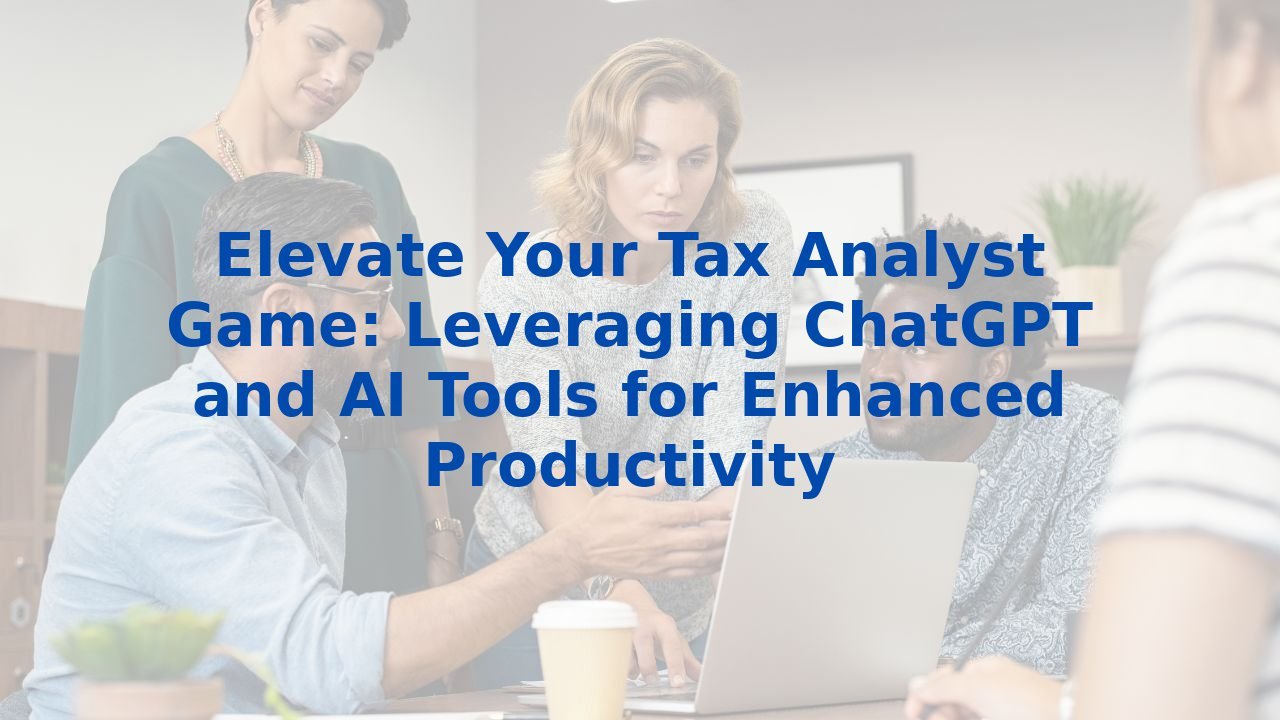Elevate Your Tax Analyst Game: Leveraging ChatGPT and AI Tools for Enhanced Productivity
Unlocking Efficiency through AI in Tax Analysis
In the fast-paced world of tax analysis, mastering efficiency is the key to success. With increasing data complexities and evolving regulations, tax analysts must find ways to streamline their workflows. Fortunately, AI offers a transformative solution. By leveraging advanced tools like ChatGPT and other AI technologies, tax analysts can automate mundane tasks, gain deeper insights, and enhance their productivity. Let’s explore how AI can become your ultimate ally in the demanding realm of tax analysis.
Practical Applications: How Tax Analysts Can Use ChatGPT
Automating Data Entry and Consolidation
Data entry and consolidation often consume valuable time that tax analysts could spend on more strategic activities. ChatGPT can automate the extraction of relevant data from various documents and spreadsheets, consolidating it into a central system. This not only reduces human error but also speeds up the entire data-processing workflow.
Drafting Reports and Summaries
Generating comprehensive reports and summaries is another area where ChatGPT shines. With the ability to understand context and pull relevant information, ChatGPT can draft detailed tax reports, compliance documents, and client summaries. This feature ensures that you remain accurate and thorough while significantly cutting down the time spent on document preparation.
Interpreting Complex Regulations
Staying abreast of constantly changing tax laws and regulations is a daunting task. ChatGPT can help tax analysts by summarizing the latest updates and offering interpretations of complex legal jargon. This ensures that you are always compliant and informed, reducing the risk of oversight.
Effective Prompts for Tax Analysts Using ChatGPT
Streamline Your Workflow with These Prompts
To fully harness the power of ChatGPT, you need effective prompts that yield the best results. Here are some examples:
“Analyze this set of transactions for potential tax deductions and summarize your findings.”
“Draft a compliance report based on the attached financial statements and recent tax regulations.”
“Summarize the changes in tax laws that have occurred in the past year and highlight their impact on corporate tax strategies.”
“Generate a tax planning strategy for a medium-sized business with the following financial data.”
Other AI Tools to Boost Tax Analyst Productivity
Optical Character Recognition (OCR) Software
OCR tools like Adobe Acrobat and ABBYY FineReader can be integrated to scan and digitize vast amounts of paper documents. This allows for quick data extraction and reduces time wasted on manual data entry.
Data Visualization Tools
Tools like Tableau and Power BI can transform raw data into insightful visualizations. These platforms help tax analysts identify trends, anomalies, and actionable insights more efficiently than traditional spreadsheet analysis.
Natural Language Processing (NLP) Tools
NLP tools can analyze emails, contracts, and other text-heavy documents to identify key information, sentiment, and compliance-related keywords. This assists tax analysts in gaining a quicker understanding of extensive documentation.
The Future: What AI Will Bring to Tax Analysis
Predictive Analytics
With advancements in AI, predictive analytics will become more accessible to tax analysts. These tools can forecast future tax liabilities, detect fraud, and suggest tax-saving opportunities based on historical data and real-time inputs.
Automated Compliance Monitoring
Future AI systems will monitor all transactions automatically to ensure ongoing compliance. Alerts will be generated in real-time for any discrepancies or potential issues, making compliance more proactive rather than reactive.
Enhanced Customization and Personalization
AI models will evolve to offer highly personalized advice tailored to specific business needs. This will enable tax analysts to provide more customized solutions and strategies to their clients, enhancing value and trust.
The Imperative for Tax Analysts: Embrace AI Now
Adapt or Be Outpaced
The message is clear: AI is not here to replace tax analysts, but rather to elevate their capabilities. Mastering AI tools enables you to get more done in less time, allowing you to focus on strategic and high-value tasks. Adaptation is critical; those who leverage AI will outperform those who don't. The adage, “Tax Analysts who use AI will take the jobs of those who don’t,” rings truer than ever.
Expand Your Earning Potential
With increased efficiency and productivity, you’ll have the ability to take on more clients, execute more complex analyses, and offer more comprehensive services. This translates to higher earning potential and career growth.
Are you looking for over 15 different ways Tax Analysts can use AI, 1000s of additional prompts to support you with your work, video training, and more? Complete AI Training supports Tax Analysts to learn AI and to always be up to date on AI. Visit Complete AI Training for more information.
Also, refer to our book that's available on Amazon Kindle: Kindle Version and Amazon Paperback: Paperback Version.



